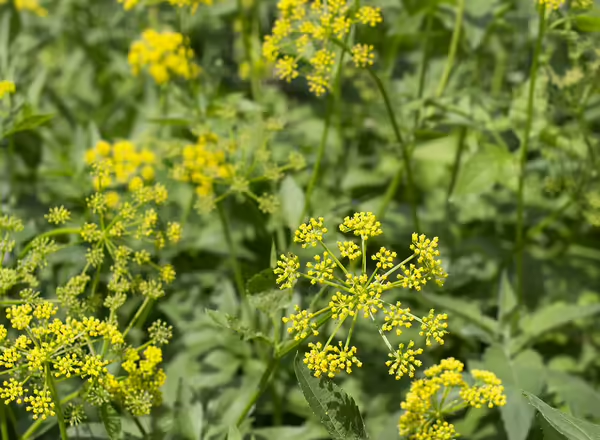
Invasive Wild Parsnip
Wild parsnip (Pastinaca sativa) is an biennial forb with potentially hazardous tendencies for those who encounter it. It is most abundant in the northern two-thirds of Illinois.
Wild parsnip can cause burn-like blisters on the skin when a broken leaf or stem touches the skin. The combination of sap on the skin and exposure to UV light causes phytophotodermatitis: Phyto (an interaction between plants) photo (and light) derm (that induces skin) itis (inflammation). The effects are likened to a severe sunburn. If exposed to wild parsnip sap, wash the area that came in contact immediately. If you begin to feel the burn, contact a physician for wound care recommendations.
Download a Wild parsnip information sheet.
History of Wild Parsnip
Wild parsnip is originally from Europe and Asia is now naturalized in North America. The cultivated parsnip that we eat heralds from wild parsnip.

Wild parsnip can be found throughout Illinois invading prairies, oak savannas, and fens, as well as roadsides, old fields, and pastures.
The first-year rosette has leaves that are alternate on the stem. The leaves are compound, and coarse with saw-toothed edges. The leaflets of the compound leaf are yellow and green on a grooved hairless stem. The flowers bloom the second year, causing it to stand 3 to 5 feet, and have an umbel — or flowering stalks growing out of a common center — of pale yellow that is reminiscent of dill.
Wild parsnip is closely related to Queen Anne’s lace and has a similar umbrella-shaped flower. Wild parsnip’s flower color is yellow, and it blooms earlier in the summer than Queen Anne’s lace.
Wear gloves, long pants, and long-sleeved shirts when working outside, in fields, or in overgrown areas that contain this plant to avoid contact with the sap. Plan weeding activities for later in the evening during low levels of sunlight to avoid activating the blistering process. Wild parsnip that has been cut and allowed to dry is safer to handle. Do not wait too long or forget to dispose of cut wild parsnip as seed can develop while the cut plant lays on the ground.
Check landscapes periodically for the presence of wild parsnip. Just because it isn’t there now, does not mean it won’t germinate next week.
Wild parsnip is a biennial, so all control activities should be done before it starts flowering or at least during the early flower stage. The basal rosettes can also be controlled in the fall to prevent flowering the next year.
- Mechanical control: Cut the root 1 to 2 inches below the soil surface. Brushcutters can be used for large populations before the seed sets. When mowing dense stands of wild parsnip, eye protection and possibly a mask can protect your eyes and lungs. For smaller populations, cut off the flowering heads and dispose in a landfill. Avoid using string trimmers where you may encounter wild parsnip. The pulverizing, flinging action of string trimmers sprays plant parts and juices everywhere. Operators are often left speckled with blisters and red rashes.
- Chemical Control: Always read and follow herbicide labels before initiating treatment. The small rosette of young wild parsnip plants can be spot treated with broad spectrum or broad-leaf specific herbicides.
For more information, explore Management of Invasive Plants and Pests of Illinois.